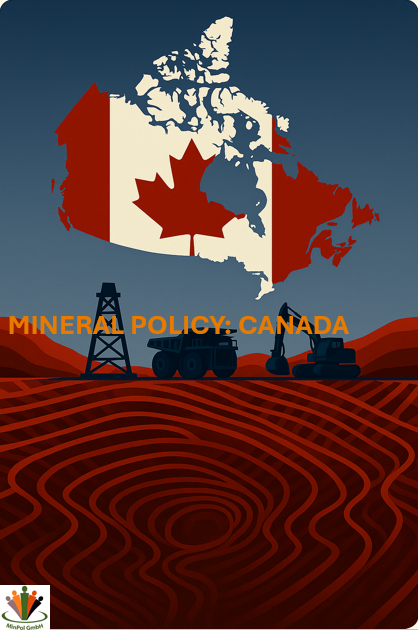From coast to coast, Canada is emerging as one of the world’s most strategic and responsible suppliers of critical minerals. As global demand for clean energy technologies, EVs, and secure supply chains hits unprecedented levels, the Canada Mineral Policy Report 2025 is your definitive guide to understanding where Canada stands—and where it’s going.
This is not just a report. It’s a launchpad for investment, policy foresight, and strategic engagement in one of the most important sectors of the 21st-century economy.
Table of Content
1. Introduction
1.1 General
1.2 Structure of the Report
1.3 Mineral Economy
2. Policy Framework
2.1 General
2.2 Canadian Minerals and Metals Policy
2.3 Canadian Critical Minerals Strategy
2.4 Recent Political Developments
2.5 Foreign Investor Benefits and Restrictions
2.6 International Treaties Related to Exploration and Mining
3. Legal Framework
3.1 Legal System
3.2 Ownership of Minerals
3.2.1 Title (Ownership)
3.2.2 Nature of Mineral Rights
3.2.3 Rights to Use Surface of Land
3.2.4 Indigenous Ownership Requirements and Restrictions
3.3 Basic Law
3.4 Other Law
4. Responsible Ministry
5. Permitting Procedure
5.1 Overview
5.2 Mining Rights and Required Licences and Permits
5.2.1 Granting of Mineral Rights
5.3 Prospecting and Exploration
5.3.1 Prospecting Right Requirements
5.3.2 Exploration
5.4 Mining Lease
5.5 Security over Mining Tenements and Related Assets
5.6 Dealing in Rights by Means of Transferring
5.7 Cancellation, Abandonment and Relinquishment
5.8 Operations, Processing and Sale of Minerals
5.9 Environmental and Social Considerations
5.9.1 Environmental Authorisations to Conduct Exploration and Mining Operations
5.9.2 Impact of Environmental Protection and Community Relations on Mining Projects
5.9.3 Environmental, Social and Governance (ESG) Guidelines and Regulations
5.9.4 Provisions Regarding Storage of Tailings
5.9.5 Closure Obligations of the Holder of an Exploration Right or Mining Right
5.9.6 Zoning or Planning Requirements for the Exercise of an Exploration or Mining Right
5.10 Royalties and Taxes
5.10.1 Other Fees
5.10.2 Tax Incentives for Mining Investors and Projects
5.10.3 Transfer Tax and Capital Gains on the Sale of Mining Projects
5.11 Mining Finance: Granting and Perfecting Security
6. Mining Cadastre
7. Mineral Resource Potential
8. List of Critical Minerals References
9. Contact of Stakeholders
9.1 Overview
9.2 Description of Stakeholders
9.2.1 Federal Government of Canada
9.2.2 Authorities
9.2.3 Advocates
9.2.4 Security Platforms
9.2.5 Mining Platforms
10. Summary and Conclusion
11. References
🍁 What Makes This Report Essential?
1. Canada’s $4B Critical Minerals Strategy, Decoded
Backed by nearly CAD $4 billion in federal funding, Canada’s updated Critical Minerals Strategy is an aggressive, full-spectrum plan—from exploration to recycling. The report provides in-depth analysis of its six priority minerals (lithium, graphite, nickel, cobalt, copper, and rare earths), and how they align with global supply chain needs.
2. The World’s Most Investable Mining Jurisdiction?
Consistently ranked among the top global destinations for mining investment, Canada offers what few others can: rich geology, world-class governance, investor protections, and Indigenous partnerships. The report walks you through provincial incentives, permitting advantages, and why Toronto and Vancouver remain global mining finance capitals.
3. A Model for ESG-Driven Mining
With leading frameworks like TSM (Towards Sustainable Mining), Canada sets a global benchmark for responsible development. The report outlines how ESG performance is being institutionalized—from impact assessments to Indigenous inclusion, mine closure obligations, and green infrastructure standards.
4. International Partnerships That Matter
Whether it’s the Canada-U.S. Critical Minerals Action Plan, EU agreements, or G7 coordination, the report details how Canada is expanding its global footprint as a secure and sustainable supplier. It also breaks down the new bilateral rules shaping trade, investment flows, and value-added processing.
5. A Province-by-Province Breakdown of Opportunity
From Québec’s battery corridor to BC’s newly launched Critical Minerals Strategy, and Ontario’s Innovation Fund for strategic metals, the report maps Canada’s internal competitive landscape—so you know where to look, and where to invest.
Who Should Read This Report?
- Investors & Analysts – Spot low-risk, high-return mining and midstream projects with a globally trusted partner.
- Government Agencies & Trade Bodies – Benchmark policy design, regulatory agility, and investment strategy.
- OEMs & Clean Tech Leaders – Align your procurement with traceable, ethical, and trade-compliant mineral sources.
- ESG, Legal & Compliance Professionals – Stay ahead of fast-evolving environmental and Indigenous engagement requirements.
Why It Matters:
Canada isn’t just producing minerals—it’s exporting certainty.
In a fractured geopolitical landscape, Canada offers what markets crave: stability, scale, and standards. The Canada Mineral Policy Report 2025 is your front-row seat to a nation that’s redefining how critical minerals are sourced, governed, and shared with the world.
🧭 Secure your copy. Position your strategy. Partner with purpose.

Associate Prof. Dr. Guenter Tiess is managing director of MinPol, Agency for international Mineral Policy. MinPol is also running an international network of experts of every branch in the field of minerals policy that is continuously growing. The network is already by now covering almost all continents, which emphasises the world-wide approach of MinPol. An economy geologist by training (PhD, Habilitation), he has more than fifteen years of experience in research on focused on international mineral policy, mining and sustainability.
Please visit http://www.minpol.com/references.html for relevant projects and published reports.

Recent Comments